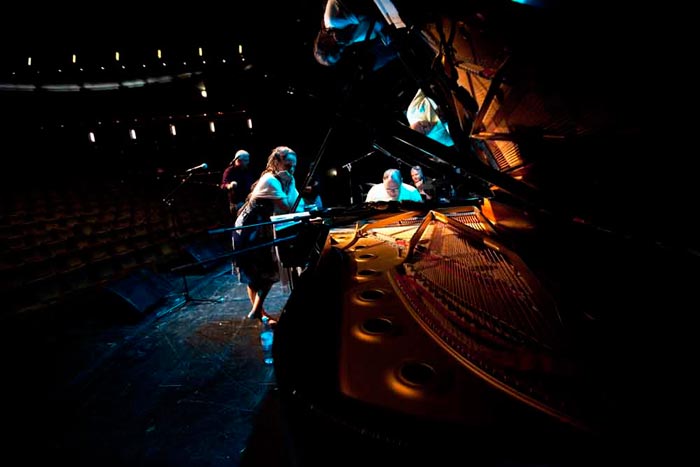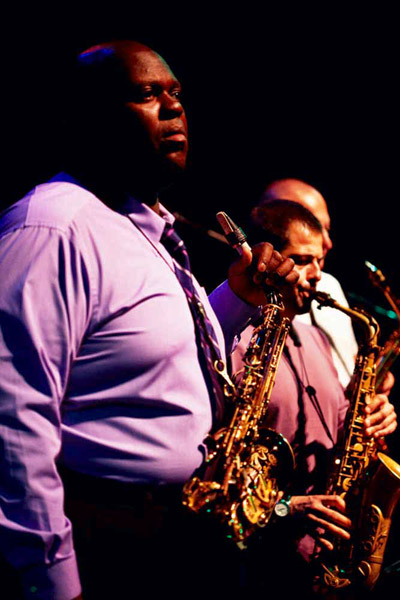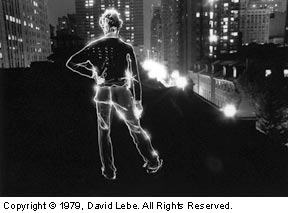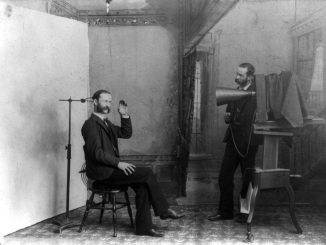
© 2010 Maya Hed. All rights reserved.
Annie Sellick (U.S), Steve Richko, R.I.P. (U.S), Pete Siers (U.S), and Paul Keller (U.S)
The Israeli Opera, Tel Aviv-Yaffo, 2010
I had the pleasure to hold an interview with the young and talented artist with the intent of discovering the metaphysical artistic inspiration she has while performing her specific art form, photography.
Q. Why did you become a photographer?
A. I wanted to dedicate my life to photography as I was thrilled by the idea of being able to create parallel worlds full of different motives and to show the key interests of individuals. I don’t want to be just another photographer. My desire is to be a photographer whose passion is evident in each and every photograph taken–a photographer who portrays a decisive point of view, who transcends the feelings of joy and humanity. I not only want to convey the message of love, but a very intriguing understanding of the universe that surrounds us.
Q. What drove you to start a project around the subject of jazz musicians?
A. I was charmed by the exquisite moments during the sound check. It is such a critical and special time for the musician as he gets ready for the concert. I had an unmistakable feeling of being cloaked in the sensation of music that never seemed to stop playing, even though at times, no instrument was being touched or played. There is no other way to describe it other than… there is a very distinct mood in the air!
Furthermore, the photographic documentation of jazz music over the past years has been mostly in black and white. I believe that it should come to life in colorful images.
Jazz is such a very distinguishable style of music and it’s not as gloomy as people tend to think. It’s full of passion and emotions, and hence, it is very exciting to take pictures within such a warm and stimulating environment.
,Stefano-Bollani-(Italy-),Jasper-Bodilsen-(Denmark),The-Israeli-Opera-Tel-Aviv-Yaffo,2009.jpg)
© 2009 Maya Hed. All rights reserved.
Antonello Salis (Italy), Stefano Bollani (Italy)
and Jesper Bodilsen (Denmark)
The Israeli Opera, Tel Aviv-Yaffo, 2009
,The-Israeli-Opera-Tel-Aviv-Yaffo,2009.jpg)
© 2009 Maya Hed. All rights reserved.
Jesper Bodilsen (Denmark)
The Israeli Opera, Tel Aviv-Yaffo, 2009
,The-Israeli-Opera-Tel-Aviv-Yaffo,2009.jpg)
© 2009 Maya Hed. All rights reserved.
Antonello Salis (Italy)
The Israeli Opera, Tel Aviv-Yaffo, 2009
,John-Webbe-(U.jpg)
© 2010 Maya Hed. All rights reserved.
Joseph Farnsworth (U.S.) and John Webber (U.S.)
The Israeli Opera, Tel Aviv-Yaffo, 2010
Q. How did you start the project?
A. During my last year of studies at The Kiryat-Ono College of Photography in Israel, I visited the 2008 Tel Aviv Jazz Festival. The music was playing, people chatted and laughed with friends, couples in love were enjoying a glass of wine, and there was a special celebration of jazz life in the air.
During the breaks between concerts I naturally started taking photographs of the jazz artists and one particular group was Mel Rosenberg and his quintet. As I was taking photographs I remember Mel’s singing smile and his moves–jazz was dancing on the stage.
Shablul-Jazz-Club,2009.jpg)
© 2009 Maya Hed. All rights reserved.
Mel Rosenberg (Canada/Israel)
Shablul Jazz Club, Israel, 2009
,The-Israeli-Opera-Tel-----Aviv-Yaffo,2009.jpg)
© 2009 Maya Hed. All rights reserved.
Tokunbo Akinro (Germany)
The Israeli Opera, Tel Aviv-Yaffo, 2009
Mel was the first musician I photographed and he introduced me to Israel’s jazz scene and to the highly talented art director Nitzan Kremer, who contributes to Israel’s jazz culture. I caught up with Mel again at the 2009 Tel Aviv Jazz Festival. He was celebrating and playing Chet Baker’s great musical achievements with other musicians, and I was taking their photographs during the rehearsals, sound check and concert.
These enlightening moments have triggered my enthusiasm for the subject and the spark to my work.
Q. What were the feelings you had while you were taking the photos? Did you hear the music that was playing while taking the photographs? Was the camera a burden?
A. The experience on the stage while taking the photos was amazing. I felt as if I jumped into the “Rabbit Hole” of live music. The artists were not playing all the time and it wasn’t really an issue for me. I felt that even when they weren’t playing music, there was still some kind of blissful atmosphere on stage.
The transition between playing, resting, enjoying the music, and the somewhat home-like atmosphere on the stage was inspiring. I was in awe of how relaxed it was, even though the stage can be a place of merciless exposure of the human being. Yet, it was a “Momentary Lapse of Reason” in its highest expression.
While taking the photographs, the camera led me rather than being a burden. I believe that a very important part of my experience was that I felt there was an interaction between my camera and the music. There were times I forgot I was taking photographs because I was so in sync with the music that was playing.
Q. What aspects were important for you?
A. THE COLOR! I wanted to share with the world my experience and my intimate emotional connection with the music created through numerous colorful images.
And just as important was the rendering of the strong interaction between the artist and his instrument. I strongly believe that a very special relationship exists between them and that the focus should not solely be on the artist but also on the instrument–the “voice” of the artist.
Q. How did you go about selecting the photos for the exhibition?
A. Though the selection process was enjoyable, exhilarating and inspiring, it was also an emotional task. I took photographs of more than 50 sound checks. How was I going to choose one photo over another? I wanted to not only showcase myself as a photographer, but to express the very special unique moments of each of the jazz musicians.
I started out with a selection of 650, 10×15 cm. photos. I spread them all around the floor of my studio and after a few days I had at least whittled the masses down to a new selection of 150. Then the process started again. I now spread those on the floor as well and after long hours of thinking and allowing the photographs to create emotional feelings within myself, I made my final selections—those best suited for the exhibition.
During this entire procedure, there was an added and unexpected bonus. I found myself being transported back in time. I was re-living and re-experiencing those sacred moments when the photographs were taken. My senses came alive once again. I could smell the wooden opera floor, and hear, “see”, and feel the music playing.
Q. Who influenced you and why?
A. I was influenced by the late William Claxton (1927-2008). He was not only a great photographer in every sense of the word, but he also had a connection with jazz photography. His photographs are full of life and freedom and I love looking at and experiencing each of them.
And the late John Cassavetes (1929-1989), a great filmmaker who was able to capture raw human emotion on screen, has strongly influenced my work. His realistic touch is what I admire when I watch his movies.
Q. Can you tell us more about the artists in this series?
A. It was an incredible experience taking photographs of so many artists and listening to their different approaches to jazz. Each and every one of the artists has his or her unique touch.
Tony Pancella is an autodidact and extremely talented pianist. His exposure to jazz began at a very young age while attending performances of his father Nicola Pancella , a pianist himself. I took photographs of Tony several times and we collectively produced and issued the CD “Live at Piano World”, which is a duet recording of him and Eric Niceberg. Tony is an extraordinary talent and spirit and whenever he plays the piano you know you are in the presence of pure genius.
Wessel “Warmdaddy” Anderson is a classic swing musician with a forceful sound and irresistible charm. He has the uncanny ability to connect with audiences with his hard swinging jazz and extraordinary performance on stage.
,The-Israeli-Opera-Tel-Aviv-Yaffo,2009.jpg)
© 2009 May Hed. All rights reserved.
Tony Pancella (Italy)
The Israeli Opera, Tel Aviv-Yaffo, 2009

© 2010 Maya Hed. All rights reserved.
Wessell Anderson (U.S), Rosario Giuliani (Italy)
and Robert Anchipolovsky (Russia)
The Israeli Opera, Tel Aviv-Yaffo, 2010
Q. What would you like the viewers to feel when they look at your pictures?
A. I would love the viewers to experience the music and the pure nirvana of the sound check for themselves.
by Melissa Kane




Leave a Reply